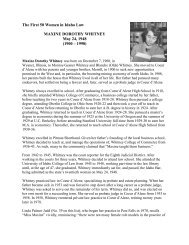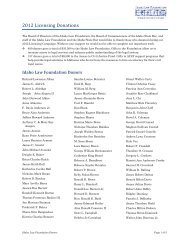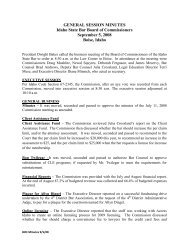The Advocate - May 2012 - Idaho State Bar - Idaho.gov
The Advocate - May 2012 - Idaho State Bar - Idaho.gov
The Advocate - May 2012 - Idaho State Bar - Idaho.gov
Create successful ePaper yourself
Turn your PDF publications into a flip-book with our unique Google optimized e-Paper software.
id a h o Co u r t s Be g i n a re v i e W o f Ca s e Pr o C e s s i n g tiM e sta n da r d s<br />
Hon. <strong>Bar</strong>ry Wood<br />
Senior District Judge<br />
Time standards create expectations<br />
for how long, on average,<br />
it should take to resolve a<br />
case. <strong>The</strong>y also provide judges<br />
and court administrators with<br />
a means of actively managing<br />
cases to prevent unnecessary delay. However,<br />
time standards do not create legal<br />
rights or obligations.<br />
<strong>The</strong> <strong>Idaho</strong> Courts are currently evaluating<br />
current time standards for the purposes<br />
of meeting public expectations, assisting<br />
judges with calendar management, and<br />
assessing the need for judicial resources.<br />
In addition to considering whether current<br />
time standards are appropriate, the <strong>Idaho</strong><br />
Supreme Court will adopt performance<br />
benchmarks and will also determine<br />
whether there should be time standards<br />
for the various stages of a given case type.<br />
For example, with respect to felony cases,<br />
rather than simply<br />
measuring the time<br />
between the initial<br />
appearance and disposition,<br />
it might<br />
be useful to measure<br />
time to initial<br />
appearance, time<br />
to indictment or<br />
information, time<br />
to plea accepted or<br />
trial initiated, and<br />
time to sentencing.<br />
<strong>The</strong> examination<br />
of cases in stages helps to facilitate active<br />
case management and provides more<br />
meaningful information, allowing judges<br />
and court administrators to more easily<br />
identify causes of unnecessary delay.<br />
We expect recommendations for modifying<br />
<strong>Idaho</strong>’s time standards to be finalized<br />
in the fall of <strong>2012</strong>, at which point<br />
proposed amendments to I.C.A.R. 57 will<br />
be forwarded to the Supreme Court for<br />
consideration.<br />
As part of the review, the judiciary<br />
is soliciting input from <strong>Idaho</strong> Supreme<br />
Court committees, judges, court staff, and<br />
attorneys. By this article, the Courts are<br />
requesting participation from the <strong>Idaho</strong><br />
<strong>Bar</strong>. This summer, in partnership with the<br />
<strong>Idaho</strong> <strong>State</strong> <strong>Bar</strong>, the <strong>Idaho</strong> Supreme Court<br />
will administer an online survey to all attorneys<br />
in <strong>Idaho</strong> to gain further insight<br />
into a variety of factors that impact case<br />
processing, including time standards. In<br />
the interim, the judiciary welcomes ques-<br />
46 <strong>The</strong> <strong>Advocate</strong> • <strong>May</strong> <strong>2012</strong><br />
Hon. <strong>Bar</strong>ry Wood<br />
tions, comments, and suggestions, which<br />
can be directed to Senior District Judge<br />
<strong>Bar</strong>ry Wood at bwood@idcourts.net or<br />
Taunya Jones at tjones@idcourts.net.<br />
<strong>The</strong> larger effort<br />
This evaluation of time standards is<br />
part of a larger effort on the part of the<br />
<strong>Idaho</strong> Courts that has been branded “Advancing<br />
Justice.” <strong>The</strong> judiciary has initiated<br />
an open-ended, top to bottom systems<br />
review to identify and eliminate sources of<br />
unnecessary delay in case processing, that<br />
is, delay that contributes nothing to due<br />
process or procedural fairness. From family<br />
law cases to problem solving courts,<br />
complex multi-party civil litigation to<br />
small claims, and felonies to infractions,<br />
all aspects of case processing are under<br />
close review.<br />
<strong>The</strong> <strong>Idaho</strong> <strong>Bar</strong> can expect to hear a<br />
great deal more about Advancing Justice<br />
in the coming months and years and will<br />
have multiple opportunities to participate<br />
in Advancing Justice efforts. Presentations<br />
will be made to several <strong>Bar</strong> Sections<br />
over the next few months as well as at the<br />
<strong>Idaho</strong> <strong>State</strong> <strong>Bar</strong>’s Annual Meeting in July.<br />
Attorneys will be invited to participate in<br />
workgroups tasked with such things as<br />
reviewing <strong>Idaho</strong> court rules and statutes<br />
to identify additional opportunities for<br />
delay reduction and developing plans to<br />
improve Bench-<strong>Bar</strong> communications on<br />
both a district and statewide level. <strong>The</strong><br />
<strong>Idaho</strong> judiciary places great value on the<br />
<strong>Idaho</strong> time standards<br />
<strong>Idaho</strong> time standards for case<br />
processing are outlined in <strong>Idaho</strong><br />
Administrative Court Rule 57<br />
(I.A.C.R. 57). <strong>The</strong> rule includes<br />
standards for ten case types:<br />
District Court civil, Magistrate<br />
Division civil, District Court felony,<br />
Magistrate Division felony, small<br />
claims, domestic relations and<br />
child support, juvenile corrections<br />
act, child protection act,<br />
misdemeanor, and infraction.<br />
thinking and recommendation of <strong>Idaho</strong><br />
attorneys and recognizes that they have a<br />
considerable stake in the outcome of the<br />
current review, particularly because any<br />
changes resulting from the current initiative<br />
may well impact the way <strong>Idaho</strong> courts<br />
conduct business for years to come.<br />
About the Author<br />
Judge <strong>Bar</strong>ry Wood is currently serving<br />
as a Senior Judge. Prior to his retirement<br />
from the bench in 2009, Judge Wood<br />
served 10 ½ years as the 5th District Administrative<br />
Judge, and served on several<br />
Supreme Court Committees, including<br />
the Supreme Court Clerk’s Manual and<br />
Training Committee. Judge Wood and his<br />
wife, Karen, spend as much time as possible<br />
outdoors enjoying hunting, fishing<br />
and gardening.









